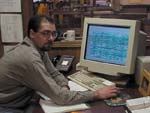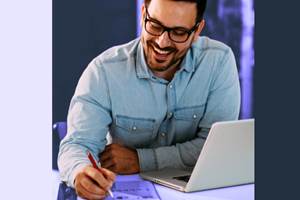New ERP System Halves Administrative Staff
This manufacturer is one of the largest contract machining shops in the Houston, Texas, area, offering machining and assembly services to the oil tool industry. The company purchased software to run its manufacturing operations more than five years ago.
Share







Takumi USA
Featured Content
View More


ECi Software Solutions, Inc.
Featured Content
View MoreKnust-SBO Precision Machining is one of the largest contract machining shops in the Houston, Texas, area, offering machining and assembly services to the oil tool industry. The company purchased software to run its manufacturing operations more than five years ago. While the software handled manufacturing work orders, job costing and financial accounting, these functions were not integrated well, which meant that data often had to be re-entered from one module to the next. Perhaps the largest data entry job involved entering time sheets for each of the company's production workers, which occupied the time of several employees. The system was unable to handle payroll, so Knust spent $500,000 per year with a service bureau on this function. Finally, scheduling remained a manual operation; a staff of four used spreadsheets and a magnetic board to manage resources. The computational complexity of the scheduling task meant that it was often impossible to give customers accurate estimates of when their jobs would be completed.
To address these issues, management decided to invest in one of the new breed of ERP systems targeted at contract machining shops. After researching different programs, Knust selected Visual Manufacturing from Lilly Software Associates (Hampton, New Hampshire). Implementing the new system has helped Knust reduce administrative staff by 50 percent through attrition. Additionally, the improved accuracy of the schedules generated by the new software has helped the company improve its percentage of on-time deliveries from 56.5 percent to 95 percent since it was implemented. "Our profits are up substantially," says Gary Knust, president, "and the new software is one of the main reasons."
Colleen Richardson, information systems manager, says that the new software has dramatically reduced administrative expenses by allowing information to be entered once, and from there it flows through the software to everyone who needs the data. "The information entered by the sales staff when they take the order, such as the shipping information, remains on the work order and never has to be entered again," she says.
As soon as the job is released, the finite scheduling module is used to determine when it can be completed and provides an accurate estimate for the customer. Information about the materials needed for the job automatically appears in the material requirements planning module. This module explores each of the orders and compares the requirements against existing stock and work in progress in order to determine which materials need to be purchased. The software consolidates demands for the same material, so that it may be combined to take advantage of quantity discounts. "This eliminates what used to be a time-consuming job of comparing paper reports of the demands for work orders against inventory levels," Ms. Richardson says.
As work begins on a job, production workers enter their time by swiping the job traveler in a bar code scanner as they complete each operation. This information is automatically transferred to the payroll system, eliminating the need for time cards. It is also immediately available to provide updates to management on how the scheduling and cost of the project compare to what was planned. The time and operation information also feeds back to the scheduling program. The software then recalculates the schedule based on the new circumstances and real-world occurrences, such as a job taking longer than expected or material that did not arrive on time. The scheduler can change the priority of jobs or move resources. "These features have made it possible to eliminate three positions that were previously required to manually schedule the shop's workload," Ms. Richardson says.
John Clark, materials manager, says that the automation of the scheduling function has also helped to dramatically improve the company's on-time delivery performance. "The software highlights the demands on each resource so that we can easily see where our bottlenecks are at any particular point–often on our horizontal CNC mills," he says. "Knowing where our bottlenecks are, we can make proactive decisions to address them, such as sending work to a subcontractor or adding a second shift for particular machines. This helps us keep the rest of the shop operating at full capacity."
Ms. Richardson summarizes that the efficiencies provided by the new software have allowed the company to reduce personnel expenses. "The production control department has been reduced from seven to two people. Inventory control has gone from two to one. In shipping, we went from seven people to five. Purchasing has been reduced from five people to one and a half. The key reason is that that the time that was previously spent transferring information from one part of the company to another isn't needed anymore because the software takes over that role."
"We always had a highly skilled and motivated workforce," Mr. Knust says. "The problem in the past was that they spent far too much of their time on menial tasks, such as passing information from one person to the next. Visual Manufacturing gives them the information they need to become fully involved in running the business. It has become a major factor in our dramatically improved operating results since it was implemented."
Related Content
How a Custom ERP System Drives Automation in Large-Format Machining
Part of Major Tool’s 52,000 square-foot building expansion includes the installation of this new Waldrich Coburg Taurus 30 vertical machining center.
Read MoreData Visibility Boosts Beryllium Shop’s Revenue
Consistency is key for beryllium manufacturing, so the data visibility granted by Harmoni has swiftly become a vital, profitable tool in the shop’s arsenal.
Read MoreRefining Shopfloor Processes for Mission-Critical Parts
Pacon Mfg, Inc. has not rested on its laurels as the 2020 Top Shop Honoree for Shopfloor Practices and Performance. In the years since, it has refined its processes to continue excelling in a volatile market.
Read MoreIncrease Savings and Streamline Purchasing Operations with Amazon Business
Machine shops and small manufacturers are finding cost and time savings using Amazon Business in their shops.
Read MoreRead Next
Setting Up the Building Blocks for a Digital Factory
Woodward Inc. spent over a year developing an API to connect machines to its digital factory. Caron Engineering’s MiConnect has cut most of this process while also granting the shop greater access to machine information.
Read MoreBuilding Out a Foundation for Student Machinists
Autodesk and Haas have teamed up to produce an introductory course for students that covers the basics of CAD, CAM and CNC while providing them with a portfolio part.
Read More5 Rules of Thumb for Buying CNC Machine Tools
Use these tips to carefully plan your machine tool purchases and to avoid regretting your decision later.
Read More





































.jpg;maxWidth=300;quality=90)








